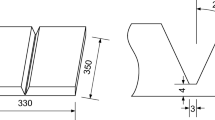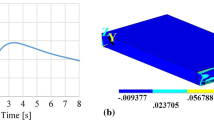Abstract
The prediction and minimization of welding distortions and the evaluation of the residual stress state after welding using numerical methods are increasingly gaining importance. These numerical models are used to optimize welding processes with respect to distortion. However, the computational time required for a transient 3-D calculation, particularly for large components, often hinders commercial usage of these approaches. Therefore, simulations have to simplify individual aspects. Due to the fact that model verification often failed according to abundant experimental research efforts, it cannot be proven whether the deformations and residual stresses calculated by those simplified models are trustworthy. With the help of the validated simulations of the IIW round robin tests and of variational calculus, this work shows the influences of sheet geometry and model simplifications, e.g. 2-D modelling, on the calculation of distortions and residual stresses. The round robin tests were performed using steel sheets made of an austenitic steel (316 LNSPH) which was bead-on-plate welded by TIG welding. The calculations for a varied sheet geometry show for the investigated process and for large components that a reduction to minimal sheet geometry is necessary and sufficient to determine the longitudinal stresses and the distortions. The transversal stresses are in general extremely sensitive to the sheet geometry.
























Similar content being viewed by others
Abbreviations
- HAZ:
-
Heat-affected zone
References
Zaeh MF, Papadakis L, Langhorst M (2008) Simulation of the manufacturing process chain of welded structures. Prod Eng Res Devel 2:385–393
Loose T, Sakkiettibutra J (2008) Leistungsmerkmale der Schweißstruktursimulation. Schweißen und Schneiden 9:487–491
Duan YG, Vincent Y, Boitout F, Leblond JB, Bergheau JM (2007) Prediction of welding residual distortions of large structures using a local/global approach. J Mech Sci Technol 21:1700–1706
Vollertsen F, Sakkiettibutra J (2008) Thermal forming and welding distortion: proceeding of the IWOTE’08. Strahltechnik, vol 31. Verlag, Bremen
Sakkiettibutra J, Loose T, Vollertsen F, Wohlfahrt H (2009) Zur Wahl des Verfestigungsmodells bei der Berechnung von Schweißeigenspannungen. In: Hildebrand J, Loose T, Gittens A (eds) Proceedings of SYSWELD Forum 2009, Universitätsverlag Weimar, pp 21–33
Zaeh MF, Branner G (2010) Investigations on residual stresses and deformations in selective laser melting. Prod Eng Res Devel 4:35–45
Williams S, Morgan S, Wescott A, Poad M, Wen S (2008) Stress engineering: control of residual stresses and distortion in welding. In: Vollertsen F, Sakkiettibutra S (eds) Thermal forming and welding distortion: proceedings of the IWOTE’08. Strahltechnik, vol 31. Verlag, Bremen, pp 229–239
Janosch JJ (2005) Round robin phase II: 3-D modelling. Updated results. IIW-X/XIII/XV-RSDP-114-05
Janosch JJ (2008) International institute of welding work on residual stress and its application to industry. Int J Press Vessel Pip 85:183–190
Wohlfahrt H, Sakkiettibutra J, Loose T, Brand M, Siegele D, Nitschke-Pagel T, Dilger K (2009) New calculations checking an adequate materials law. New results on distortion measurements. Report on the round robin tests on residual stresses 2009. IIW Document IIW-X-1668-09, IIW-XIII-2291-09, IIW-XV-1326-09
Janosch JJ (2001) IIW round robin protocol for residual stress and distortion prediction, phase II (proposal rev. 1). IIW-Document IIW-X/XV-RSDP-59-0.1
Wohlfahrt H, Dilger K (2008) New results of the IIW round robin residual stress measurements. IIW-document IIW-XIII-2241-08, IIW-XV-1283-08
Loose T, Sakkiettibutra J, Wohlfahrt H (2010) New 3-D calculations of residual stresses consistent with measured results of the IIW round robin programme. In: proceedings of the mathematical modelling of weld phenomena Bd. 9, Verlag der Technischen Universität Graz, pp 369–390
Goldak J, Chakravarti A, Bibby M (1984) A new finite element model for heat sources. Metall Trans B 15B:299–305
Acknowledgments
The authors like to express their gratitude to the Government of the City of Bremen for financial support of the reported work.
Author information
Authors and Affiliations
Corresponding author
Rights and permissions
About this article
Cite this article
Sakkiettibutra, J., Vollertsen, F. Possibilities and limitations of geometric simplifications for calculations of residual stresses and distortions. Prod. Eng. Res. Devel. 5, 485–495 (2011). https://doi.org/10.1007/s11740-011-0309-y
Received:
Accepted:
Published:
Issue Date:
DOI: https://doi.org/10.1007/s11740-011-0309-y




